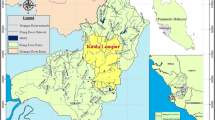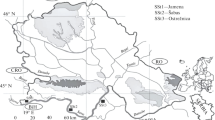Abstract
This study investigates six water quality monitoring stations in the watershed of the Feitsui Reservoir. It uses nine parameters of water quality collected in an interval of two and half years for factor analyses, which was first conducted to determine four types of factors, respectively, those for organic pollution, eutrophication, seasonal influence, and sediment pollution. The analysis results effectively help to determine water quality in the watershed of the reservoir. The authors reutilize analysis of moment structures (AMOS) to acquire further results in order to confirm the goodness of fit of the previous factor analysis model. During the confirmation, we examine the hypothesized orthogonal results as well as utilize oblique rotation to explore the goodness of fit of the reflective indicators of the orthogonal rotation. As shown in the algorithm results, as long as the covariance curve is included in the four factors, no related issues are detected in the goodness of fit of reflective indicators and interior and external quality is reported with excellence. The orthogonal model, thus, stands. Additionally, when the analysis of structural equation modeling (SEM) is conducted, sample data mismatches the hypotheses of multivariate normality. Therefore, this study adopts the generalized least square (GLS) for an algorithm. Research results of this study have been submitted to the reservoir management authorities in Taiwan for the improvement of statistical application and strategic evaluation of water quality monitoring data in order to strengthen the managerial effectiveness of water quality in watersheds.




Similar content being viewed by others
References
Arbuckle, J. L. (1994). Computer announcement: AMOS: analysis of moment structures. Psychometrika, 59, 135–141.
Arbuckle, J. L., & Wothke, W. (1999). IBM AMOS 4.0 user's guide, Chicago, IL, USA.
Bagozzi, R. P., & Yi, Y. (1988). On the evaluation of structural equation models. Academy of Marketing Science, 16, 76–85.
Bollen, K. A. (1989). Structural equations with latent variables. New York: Wiley.
Bollen, K. A. (1989). A new incremental fit index general structural equation models. Sociological Methods & Research, 17, 303–310.
Burnham, K. P., & Anderson, D. R. (1998). Model select and inference: a practical information-theoretic approach. New York: Spring-Verlag.
Charlton, A. J., Robb, P., Donarski, A. J., & Godward, J. (2008). Non-targeted detection of chemical contamination in carbonated soft drinks using NMR spectroscopy, variable selection and chemometrics. Analytica Chimica Acta, 618, 196–205.
Chen, S. Y. (2005). Multivariate analysis (4th ed.). Taipei: Huatai Publisher. in Chinese.
Chen, Y. S., Huang, T. W., & Huang, F. M. G. M. (2006). Basic principles of structural equation modeling. Kaohsiung: Li-Wen Publisher. in Chinese.
Einax, J. W., Truckenbrodt, D., & Kampe, Ο. (1998). River pollution data interpreted by means of chemometric methods. Microchemical Journal, 58, 315–321.
Helena, B., Pardo, R., Vega, M., Barrado, E., Ferna’ndez, J. M., & Ferna’ndez, L. (2000). Temporal evolution of groundwater composition in an alluvial aquifer (Pisuerga river, Spain) by principal component analysis. Water Research, 34, 807–815.
Hsieh, P. H., Kuo, J. T., Wu, E. M.-Y., Ciou, S. K., & Liu, W. C. (2010). Optimal best management practice placement strategies for nonpoint source pollution management in the Fei-Tsui reservoir watershed. Environmental Engineering Science, 27, 441–447.
Lin, C., Wu, E. M.-Y., Lee, C. N., & Kuo, S. L. (2011). Applying multivariate statistical factor analyses on selecting an optimal method for recycling of food wastes. Environmental Engineering Science, 28, 349–356.
Liu, C. W., Lin, K. H., & Kuo, Y. M. (2003). Application of factor analysis in the assessment of groundwater quality in a blackfoot disease area in Taiwan. Science of the Total Environment, 313, 77–85.
MacGregor, J. F., & Kourti, T. (1995). Statistical process control of multivariate process. Control Engineering Practice, 3, 403–410.
Nunnari, G., Dorling, S., Schlink, U., Cawley, G., Foxall, R., & Chatterton, T. (2004). Modelling SO2 concentration at a point with statistical approaches. Environmental Modelling and Software, 19, 887–897.
Pires, J. C. M., Sousa, S. I. V., Pereira, M. C., Alvim-Ferraz, M. C. M., & Martins, F. G. (2008). Management of air quality monitoring using principal component and cluster analysis-part I: SO2 and PM10. Atmospheric Environment, 42, 1249–1255.
Pires, J. C. M., Sousa, S. I. V., Pereira, M. C., Alvim-Ferraz, M. C. M., & Martins, F. G. (2008). Management of air quality monitoring using principal component and cluster analysis—part II: CO, NO2 and O3. Atmospheric Environment, 42, 1261–1268.
Simeonov, V., Stratis, J. A., Samara, C., Zachariadis, G., Voutsa, D., Anthemidis, A., et al. (2003). Assessment of the surface water quality in Northern Greece. Water Research, 37, 4119–4125.
Tajik, S., Ayoubi, S. S., & Nourbakhsh, F. S. (2012). Prediction of soil enzymes activity by digital terrain analysis: comparing artificial neural network and multiple linear regression models. Environmental Engineering Science, 29, 798–808.
Theodora, K. (2006). The process analytical technology initiative and multivariate process analysis, monitoring and control. Analytical and Bioanalytical Chemistry, 384, 1043–1551.
Ticlavilca, A., & McKee, M. (2011). Multivariate Bayesian regression approach to forecast releases from a system of multiple reservoirs. Water Resources Management, 25, 523–532.
Varol, M., Gökot, B., Bekleyen, A., & Şen, B. (2012). Water quality assessment and apportionment of pollution sources of Tigris river (Turkey) using multivariate statistical techniques—a case study. River Research and Applications, 28, 1428–1436.
Wu, E. M.-Y., & Kuo, S. L. (2012). Applying a multivariate statistical analysis model to evaluate the water quality of a watershed. Water Environment Research, 84, 2075–2085.
Wu, E. M.-Y., Kuo, S. L., & Liu, W. C. (2012). Generalized autoregressive conditional heteroskedastic model for water quality analyses and time series investigation in reservoir watersheds. Environmental Engineering Science, 29, 227–237.
Wunderlin, D. A., Diaz, M. P., Ame, M. V., Pesce, S. F., Hued, A. C., & Bistoni, M. A. (2001). Pattern recognition techniques for the evaluation of spatial and temporal variations in water quality—a case study: Suquia river basin (Cordoba-Argentina). Water Research, 35, 2881–2882.
Yang, Y. H., Zhou, F., Guo, H. C., Sheng, H., Liu, H., Dao, X., et al. (2010). Analysis of spatial and temporal water pollution patterns in Lake Dianchi using multivariate statistical methods. Environmental Monitoring and Assessment, 170, 407–416.
Acknowledgments
The authors sincerely appreciate financial supports for the project (NSC 100-2221-E214-011) from Taiwan’s National Science Council for the work.
The authors also deeply appreciate the anonymous reviewers for their insightful comments and suggestions.
Author information
Authors and Affiliations
Corresponding author
Rights and permissions
About this article
Cite this article
Wu, E.MY., Tsai, C.C., Cheng, J.F. et al. The Application of Water Quality Monitoring Data in a Reservoir Watershed Using AMOS Confirmatory Factor Analyses. Environ Model Assess 19, 325–333 (2014). https://doi.org/10.1007/s10666-014-9407-5
Received:
Accepted:
Published:
Issue Date:
DOI: https://doi.org/10.1007/s10666-014-9407-5




